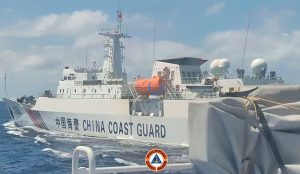Chinese coast guard vessels have maneuvered dangerously close to Philippine Coast Guard (PCG) on at least four occasions over the past year near a disputed shoal in the South China Sea, the Philippine government said yesterday. In a statement, the PCG reported “a close distance maneuvering” incident involving a Chinese Coast Guard (CCG) vessel during a maritime patrol operation close to Scarborough Shoal on March 2.
According to the statement, the incident involved the CCG vessel 3305 moving to within approximately 21 yards of PCG’s BRP Malabrigo (MRRV-4402) in the waters of Bajo de Masinloc (Panatag Shoal). As a result, BRP Malabrigo’s space for maneuver was “constrained” by the CCG vessel’s action, which the PCG said increased the risk of collision and was “a clear violation of the 1972 International Regulations for Preventing Collisions at Sea.” (The PCG has also released what it claims is a video of the incident.)
“The behavior of the involved CCG vessels increased the risk of collision with four of our capital ships,” PCG Commandant Adm. Artemio Abu told the media, adding that the coast guard had asked the Philippine Department of Foreign Affairs to help address the issue through “rules-based and peaceful approaches.” It was unclear whether Manila had or was intending to issue a formal demarche to protest the Chinese vessel’s action.
Known to the Philippines as Panatag Shoal and to China as Huangyan Dao, Scarborough Shoal is a triangular reef surrounding by rich fishing grounds about 200 kilometers off the coast of the Philippines’ Luzon island, and around 600 kilometers from China.
Scarborough Shoal has been under Chinese control since 2012, when the two nations engaged in a tense, 10-week stand-off that resulted in China occupying it, despite an agreement for mutual withdrawal from the shoal. Since then, CCG vessels have surrounded the shoal and restricted access to Filipino fishermen from nearby Luzon.
The incident was crucial to pushing the administration of then President Benigno Aquino to file a formal complaint with an arbitral tribunal at the Permanent Court of Arbitration in The Hague, challenging a number of China’s maritime claims and activities in the South China Sea. In 2016, the tribunal handed down its award supporting most of the Philippines’ claims and rejecting the legal basis for China’s.
The PCG report is just the latest evidence of China’s pressure in disputed regions of the South China Sea, pressure that hasn’t significantly let up since President Rodrigo Duterte set aside the arbitral victory and worked with Beijing directly to address the disputes. From March to May of last year, at least 220 Chinese vessels, including maritime militia ships, anchored around the Whitsun Reef in the Spratly Islands, under dubious pretexts.
Then last November, the Philippines condemned “in strongest terms” the actions of three CCG vessels after the latter blocked and fired water cannons on boats attempting to resupply a Second Thomas Shoal, where a small contingent of Philippine marines dwell in a purposely grounded navy ship.
As Erick Nielson C. Javier of the National Defense College of the Philippines wrote in these pages last week, the pattern of persistent Chinese pressure suggests that the policy of the Duterte administration – of pursuing productive negotiations with the Chinese side over the maritime and territorial disputes – has failed in its goals.
Javier goes on to make the case for the Philippines to shift from a reactive policy of defending its maritime features and the surrounding ocean expanses against Chinese incursions to a proactive policy of deterring Chinese actions from taking place to begin with. What that might involve, given the wide gulf in resources and capability between the two sides, remains less clear. But with an impending change of administration following the presidential election in May, this looms as the ideal time to recalibrate the Philippines’ approach to the South China Sea disputes.

































